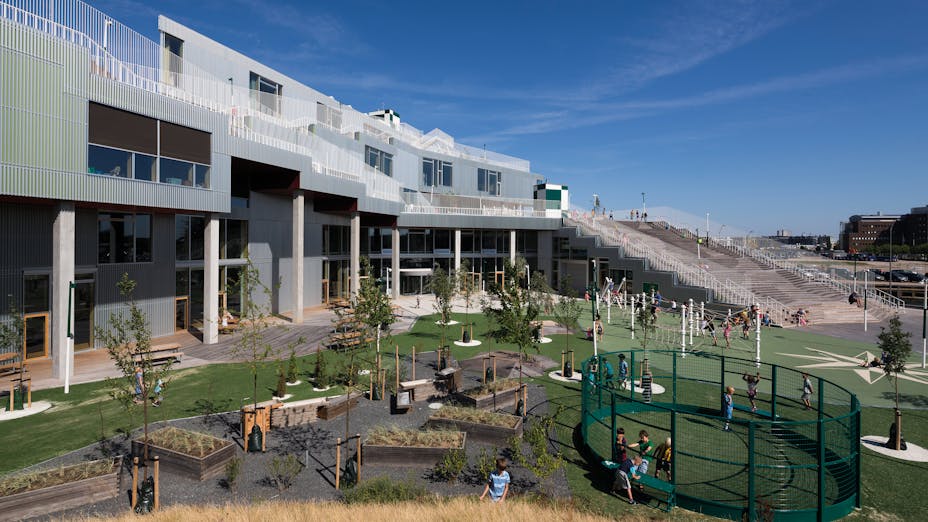The building intends to convey a spaciousness and dynamic shift from what society has been conditioned to expect from a school. Surprises and new experiences are central concepts for the school and the floorplan and height from floor to ceiling varies throughout the building. The idea behind this design is to ensure students, teachers and visitors are met with challenges and thereby stimulated as they move throughout indoor and outdoor environments that support the children’s learning processes and social abilities.
South Harbour School in Copenhagen is a good example of the way different ROCKWOOL products interact to create buildings that are set for modern living – with focus on energy efficiency, acoustic performance as well as surprising design.
International architecture award
The South Harbour School has received one of the world's largest international architecture awards, the World Architecture News (WAN) education award 2016, further to national Danish awards. The school is included at the International Architecture Exhibition 'Venice Biennale 2016' as part of the Danish pavilion.
The 9,500 m2 landmark school opened in august 2015 and is built according to the Danish low-energy class 2015. The population in Copenhagen is currently growing fast like in many other major cities so the municipality has invested in increasing and improving its school facilities.
Acoustic and fire safe insulation
The school also features a number of technical solutions that aid in creating a good indoor and acoustically controlled environment while also keeping energy consumption at a minimum level. Various studies show that good use of acoustics have a positive impact on the students' learning process and wellbeing, therefore acoustics have been one of the major focus areas throughout the project. For this, ROCKWOOL fire safe thermal insulation and ROCKFON acoustic ceilings have been used.
Eye-catching facade cladding conveying spaciousness
The spaciousness and ever-changing dynamics of the building are also represented in the facade. The artist Peter Holst Henkel has made the artistic decoration and used the facade as a canvas, beautifully reflecting the interaction between art and architecture.
The artwork appearing on the ROCKPANEL boards consists of colours, graphics and wavy pieces of text from Hans Christian Andersen's famous fairy tales. This results in an ever-changing facade that reveals new perspectives depending on the amount of daylight, and the position from which a person views the building.
Future proof, sustainable ROCKWOOL solutions
With its contextual design, the school is an active and socially sustainable part of the new neighbourhood in Copenhagen. Furthermore, various energy solutions such as high-efficiency insulation, density, natural ventilation as a supplement to the mechanical ventilation, solar cells and intelligent lightning control are incorporated into the overall design. The green roof adds to the overall sustainability of the project.
The South Harbour School is designed by JJW Architects in Copenhagen. According to Jørn Kiesslinger, Architect at JJW Architects, developers must increasingly pay attention to the life cycle of building components as we gradually move towards a circular economy.
In this context he considers ROCKWOOL products like the ROCKPANEL board material to be a strong solution. He explains: "ROCKPANEL facade cladding has a clear product advantage in the new economy. It is in fact possible to recycle the boards after the end-of-life stage and use this as part of the raw material for new boards. As architects focusing on sustainability, we like these closed life cycles to become reality."
Kiesslinger continues: "In our sustainability screening, we compared the Environmental Product Declaration (EPD) of the ROCKPANEL boards with those of other cladding materials. It turned out that the boards made from the sustainable source basalt have a lower environmental impact both in terms of energy use and CO2 emissions during production. According to the EPD, the product life of the ROCKPANEL products is 60 years, another important point when we want to build in a sustainable way."

